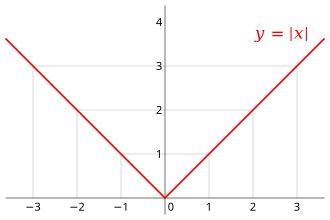A-level Mathematics/CIE/Pure Mathematics 2/Algebra
The Modulus Function
The modulus function[note 1] returns the magnitude of . For instance, will return , will return .
The modulus function can be defined as .

Graphing the modulus function
Graphs of the modulus function are just a straight-line graph that has been reflected for negative output values. The graph of is like the graph of except that every point below the x-axis folds upwards to produce a V-shaped graph.
Here is an interactive graph which shows the relationship between the graph of a line and the graph of the modulus of that line.
Solving Equations & Inequalities
To solve equations and inequalities involving the modulus function, we can square both sides.
e.g. Solve
An alternative method is to look at the places where the functions inside the modulus change sign, i.e. where .
changes sign at
changes sign at
Dividing Polynomials
Dividing polynomials uses the same method as dividing numbers with long division.
Dividing Numbers
Suppose we need to find . We can use the method of long division:
______
17|22253
__1___
17|22253 17 goes into 22 once with 5 left over
-17↓
52 Next we bring down the 2
__13__
17|22253
-17↓↓
52↓ 17 goes into 52 thrice with 1 left over
-51↓
15 Next we bring down the 5
__1309
17|22253
-17↓↓↓ 17 doesn't go into 15, so we bring down the 3
52↓↓
-51↓↓
153 17 goes into 153 nine times with nothing left over
-153
0
Thus,
Dividing Polynomials
We can use the same method to divide polynomials.
e.g.
____________________
x + 1 |x^3 + 2x^2 + 2x + 1
________x^2_________
x + 1 |x^3 + 2x^2 + 2x + 1 (x + 1) goes into (x^3 + 2x^2) x^2 times with x^2 left over
-(x^3 + x^2) ↓
x^2 + 2x Bring down the 2x
________x^2_+__x____
x + 1 |x^3 + 2x^2 + 2x + 1 (x + 1) goes into (x^2 + 2x) x times with x left over
-(x^3 + x^2) ↓ ↓
x^2 + 2x ↓ Bring down the 1
-(x^2 + x) ↓
x + 1
________x^2_+__x___1
x + 1 |x^3 + 2x^2 + 2x + 1 (x + 1) goes into (x + 1) once with nothing left over
-(x^3 + x^2) ↓ ↓
x^2 + 2x ↓
-(x^2 + x) ↓
x + 1
-(x + 1)
0
Thus,
The Remainder Theorem
A remainder occurs when the divisor does not fit into the dividend a whole number of times.
e.g. has a remainder of .
It can also occur in polynomials:
____________________
x + 2 |x^3 + 3x^2 + 3x + 3
________x^2_________
x + 2 |x^3 + 3x^2 + 3x + 3
-(x^3 + 2x^2) ↓
x^2 + 3x
________x^2_+__x____
x + 2 |x^3 + 3x^2 + 3x + 3
-(x^3 + 2x^2) ↓ ↓
x^2 + 3x ↓
-(x^2 + 2x) ↓
x + 3
________x^2_+__x_+_1
x + 2 |x^3 + 3x^2 + 3x + 3
-(x^3 + 2x^2) ↓ ↓
x^2 + 3x ↓
-(x^2 + 2x) ↓
x + 3
-(x + 2)
1
Here, the remainder is .
This can be expressed as
In general, a quotient and remainder can be expressed as
This expression leads to a useful theorem in mathematics: the remainder theorem.
If we divide a polynomial by a given divisor , the expression can be written as .
If we substitute the value of into the polynomial, we get:
Thus, the remainder theorem states that for a given polynomial , gives the remainder obtained from .
e.g. If , will give the remainder obtained from :
The Factor Theorem
The factor theorem is a special case of the remainder theorem for when the remainder is zero.
If the remainder is zero, that means that the divisor is a factor of the dividend.
Thus, if , is a factor of
e.g. . Use the factor theorem to find a factor of .
- Notes
- ↑ Also known as the absolute value function